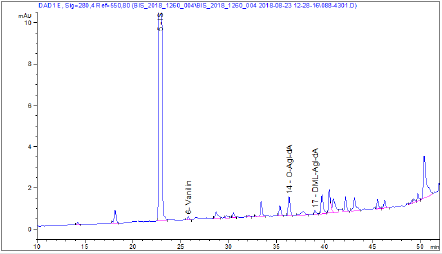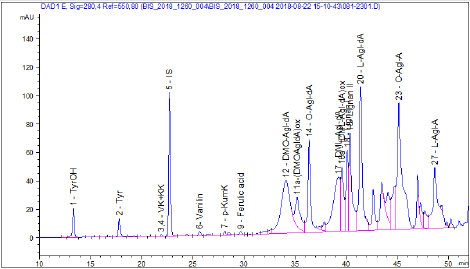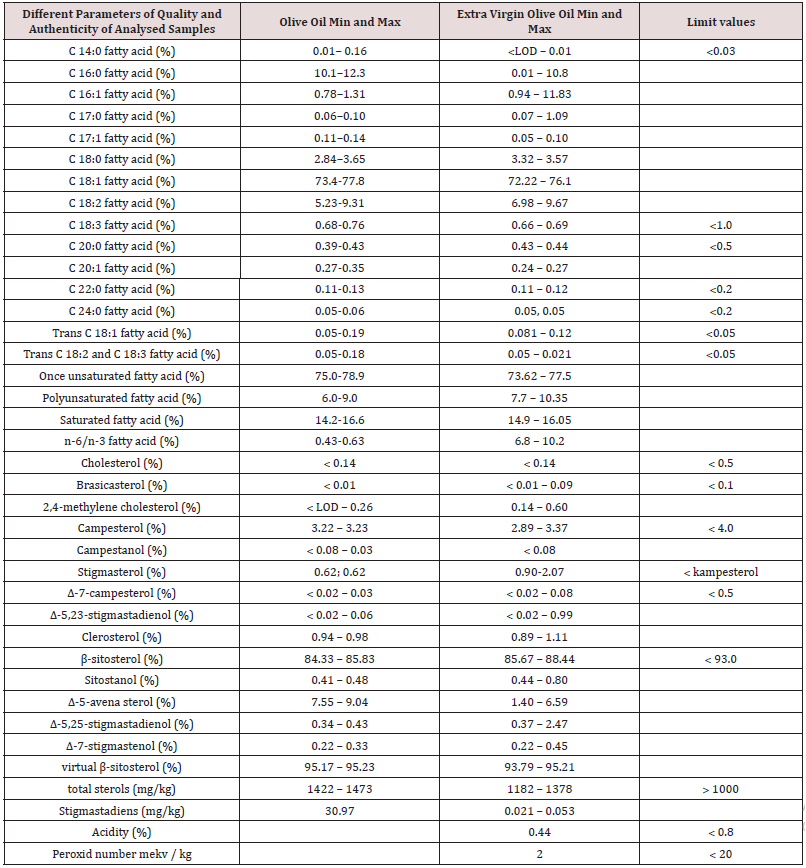Lupine Publishers | Journal of Food & Nutrition
Abstract
Background: The assessment of the quality extra virgin olive oils used as liquid medium in canned fish together with the levels of phenolic compounds is very important in order to evaluate if the higher price of the extra virgin olive oil in canned fish in comparison with fish in olive oil is justified.
Objective: The aim of the study was to identify and quantify the phenolic compounds in processed food such as canned fish in order to assess the added value of extra virgin olive oil used as a liquid medium in canned fish. The authenticity of olive oils used as liquid medium in canned fish was assessed by determination of sterol composition, fatty acid composition and content of stigmastadiens.
Materials and Methods: Various fish products in olive oil or extra virgin olive oil were sampled randomly from different manufactures on the Slovenian market. The content of oil was first separated from fish and then immediately analyzed for sterol composition and concentrations, fatty acid composition, stigmastadiens levels, acidity, peroxide number and phenolic compounds composition and content.
Conclusion: Oil in canned fish products corresponded to the declared labelling on the packaging. However, the levels of determined phenolic compounds were much lower and the composition of phenolic compounds was different compared to the usual extra virgin olive oil from Slovenian producer.
Introduction
Fish products are often sold together with vegetable oil such as olive oil. Lately, the market also offers fish products with extra virgin olive oil. Olive oil which contains 98-99% triacylglycerols and a high proportion of stable oleic acid can provide combined with fish meat the recommended ratio between n-3 and n-6 fatty acids [1-3]. Olive oil can also represent a significant source of antioxidants such as vitamin E and a source of various phenolic compounds that are not present in other foodstuff [4, 5]. Antioxidants such as phenolic compounds in olive oil can not only have a protective role on human health [6], but they can also protect the important compounds such as unsaturated fatty acids against oxidation [7]. However, due to the high costs of olive oil production, the frauds such as adding cheaper oils to olive oil can be found. Moreover, products such as fish products in olive oil, where fish meat may cover the specific taste of olive oil, can often be the target of frauds. Due to the increased possibility of frauds, the market norms for olive oil compared to other oils are very strict. However, olive oils sold together with fish meat are not addressed. According to Commission Regulation (EEC) No. 2568/91 and Commission Implementing Regulation (EU) No. 1348/2013 the sterol composition, fatty acid composition and the determination of stigmastadiens in olive oil are important indicators for olive oil authenticity. Overall, the assessment of the quality extra virgin olive oils used as liquid medium in canned fish is very important in order to evaluate if the higher price of the extra virgin olive oil in canned fish in comparison with fish in olive oil is justified. While the phenolic compounds from olive oils have an important protective role on human health and prevent oils from oxidation, the main aim of the study was to identify and quantify the phenolic compounds in processed food such as canned fish in order to assess the added value of extra virgin olive oil used as a liquid medium in canned fish. In addition, the authenticity of olive oils used as liquid medium in canned fish available on the Slovenian market was assessed by the determination of sterols composition and content, fatty acid composition and the levels of stigmastadiens. As far as we are concerned this is the unique study that involves the determination of phenolic compounds in olive oil from processed food available on the Slovenian market by high performance equipment. The results obtained in this study will help the testing olive oil laboratories to better evaluate the quality and potential frauds of extra virgin olive oil added to processed food such as canned fish.
Materials and Methods
Various canned fish products (n=16) containing olive oils and extra virgin olive oil used as liquid medium were collected randomly in the city of Koper in January, February of 2016 and in August and September 2018. Canned tuna in olive oil, canned tuna in extra virgin olive oil, canned mackerel in extra virgin olive oil from different manufacturers were bought in different supermarkets in 2016 and 2018. Each type of canned fish products available containing extra virgin olive oil as a liquid medium from different manufactures were sampled. The content of oil was first separated from fish and then immediately analysed for the selected compounds. Sterols composition and the sterols content in olive oil from canned fish was determined by thin layer chromatography and capillary gas chromatography with flame ionization detector (GC-FID) [8]. The fatty acid composition of olive oil was determined by in situ transesterification with GC-FID [9]. The content of stigmastadienes in olive oils samples were determined by the column and capillary gas chromatography [10]. The determination of acidity and peroxide number was carried out according to the standard methods [11,12]. The phenolic composition of olive oils was determined by high performance liquid chromatography - mass spectrometry (HPLC-ESI-QqQ) [13,14] and the unknown compound present in high levels was additionally identified by HPLC-ESI-qTOF [15].
Materials and Methods
Table 1 shows that the fatty acid composition of the samples does not correspond to the typical fatty acid composition of olive or extra virgin olive oil. The differences might be due to migration of fatty acid from fish into the oil, heat treatment of fishery products in olive oil or the addition of refined oil. The exceeded values of trans fatty acids could be due to the heat treatment of canned fishery products in olive oil or the addition of refined oil. Likewise, from the table 1 is shown that sterol composition is not typical for olive oil. This is most likely due to sterol migration from fish to vegetable olive oil. The content of stigmastadienes is elevated only in olive oils that are not declared as extra virgin olive oils. Therefore, this confirms that the extra virgin olive oil in analyzed samples is properly declared and that stigmastadiens determination could be the right method to distinguish the refined oil from extra virgin olive oil in canned fish samples. Moreover, quality parameters as free fatty acid content and peroxide number of declared extra virgin olive oils corresponds to the limits determined for the category of extra virgin olive oil, therefore, below or equal to 0.8% (acid limit for the extra virgin olive oil category) and below or equal to 20 mekv / kg (the peroxide number limit for the extra virgin category of olive oil). The content of total phenolic compounds in oils from canned fish were approximately 100 times lower compared to the levels find in declared extra virgin olive oil from Slovenian producer (Table 2, [16]). As was expected the content of phenolic compounds was the lowest in refined olive oil. However, the levels of total phenolic compounds in extra virgin olive oils were only slightly higher (Table 2). The levels of the end oxidation compound tyrosol and hydrohytyrosol of the main phenolic compounds in olive oil secoiridoids were low. This suggests that olive oils were low in phenolic compounds previous the heat treatment. From figures 1-3 the differences in composition of phenolic compounds of refined olive oil from canned tuna (Figure 1), extra virgin olive oil from canned tuna (Figure 2) and extra virgin olive oil from Slovenian producer (Figure 3). Extra virgin and refined olive oils added to fish products had significantly lower content of oleuropein and ligstroside derivatives, that are highly appreciated antioxidants in the quality extra virgin olive oils. In the Figure 2 the high unusual peak for typical extra virgin olive oils was observed. With HPLCqTOF was determined that the unusual pick was represented by the compound with molecular formula C10H12O4 could be ferulic acid derivate or hydroxytyrosol acetate.
Figure 1: The chromatogram determined by DAD at 280 nm in a sample of refined olive oil added to canned fish.

Figure 2: The chromatogram determined by DAD at 280 nm in a sample of extra virgin olive oil added to canned fish.

Figure 3: The chromatogram determined by DAD at 280 nm in a sample of extra virgin olive oil from Slovenia producer.

Table 1: Different parameters of quality and authenticity of analysed samples such as fatty acid composition of olive oil, determination of sterols, stigmastadiens, acidity and peroxide number.

Conclusion
Even though by the quality parameters it is clear that oil in canned fish products corresponds to the declared labelling on the packaging, the levels of determined phenolic compounds were much lower than it is expected for extra virgin olive oils. In addition, the composition of phenolic compounds was different compared to the usual extra virgin olive oil from Slovenian producer.
Acknowledgement
This research was partially sponsored by Post‐doctoral project from University of Primorska untitled “Development of analytical methods for determining the potencies and the quality of fish products in olive oil for the purpose of ensuring the nutritional security of the population”. The author gratefully acknowledges the European Commission for funding the InnoRenew CoE project (Grant Agreement #739574) under the Horizon 2020 Widespread- Teaming program. The authors are also greatful to Saša Volk and dr. Vasilj Valenčič who perfromed the analysis of fatty acids compostion, sterol composition and concentartions, peroxide number and acidity of the olive oil samples involved in this study.
Read More About Lupine Publishers Journal of Food & Nutrition Please Click on Below Link:
https://lupine-publishers-food-and-nutrition.blogspot.com/


No comments:
Post a Comment
Note: only a member of this blog may post a comment.